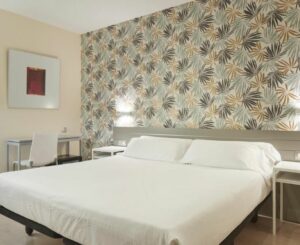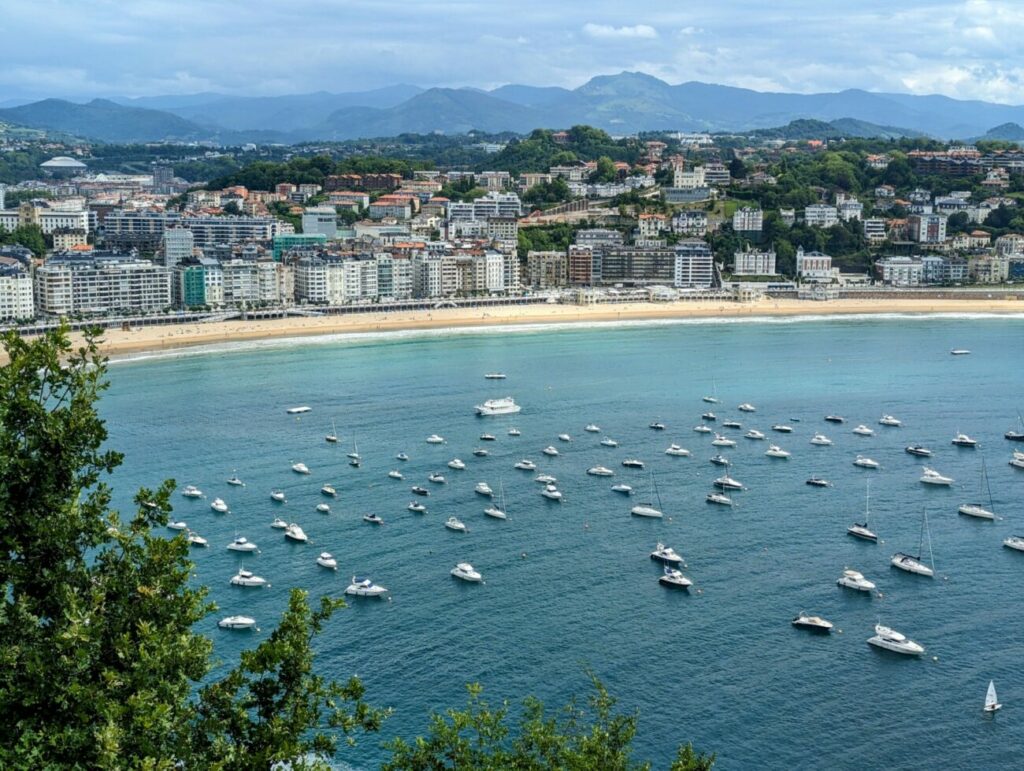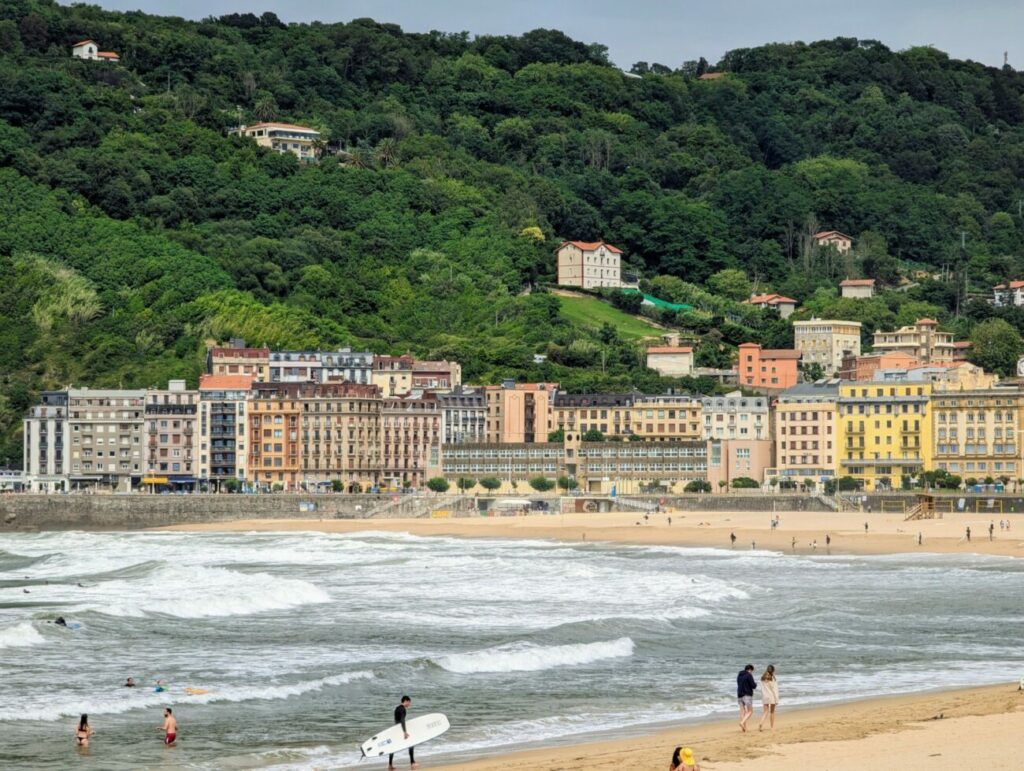San Sebastian is located in the Basque Country in the far northeast of Spain and should be the first or last place you visit on your northern Spain road trip. San Sebastian is simply a jewel of a city and we really enjoyed it. Do you want to know what are the best things to do in San Sebastian? Or if a visit to San Sebastian is really worth it? And which tips will make your day in San Sebastian even better? Then just read on.
San Sebastian Donostia in Northern Spain
Although we’re not really city people and prefer to be in nature rather than civilization, San Sebastian totally blew us away. In our northern Spain travel guide we read something about the “most beautiful city in the world” and although we have an aversion to such exaggerations, we wanted to give the city a chance. And what can we say, it was totally worth it.
San Sebastian is really a highlight in Northern Spain and should be part of every Northern Spain itinerary.
San Sebastian is located at the very edge of the Iberian Peninsula at a bay with the beautiful name La Concha, which means the shell. The name comes from the curved shape of the bay. The beautiful city beach of San Sebastian (Playa La Concha) is also curved in this way, creating a unique flair on the promenade that made us think more of the Mediterranean Sea and St. Tropez than of rugged northern Spain.
The beach is framed by two large rock massifs, Monte Igueldo and Monte Urgull. Both can be climbed, by the way, and both offer fantastic viewpoints of the city.
By the way, the city fathers and mothers have managed to leave the cityscape almost unchanged over the centuries. The city lives mainly from tourism, but there are no large hotel castles or other buildings that spoil the cityscape. For example, the panorama of Concha Bay has been identical for almost 200 years, creating the unique atmosphere of the city.
Fun fact: Where does the double name of the city actually come from?
Donostia San Sebastian is a double name and consists of a Spanish and a Basque part. In fact, San Sebastian is located in the autonomous region of Basque Country, where all signs and names are always bilingual. On the one hand Spanish and on the other hand Basque. Both languages have nothing in common, neither in spelling nor in pronunciation.
The Basque name Donostia has developed from Done Sebastian. Done is the Basque variant of the Spanish San and is prefixed to saints’ names (in English, the equivalent is St., as in St. Patrick). In the course of time Done Sebastian became the short form Donebastia and then Donostia. So Donostia is the Basque variant of San Sebastian and so it came to the double name Donostia San Sebastian.
Things To Do in San Sebastian Donostia
#1 Stroll through the Old Town
The old town is definitely one of the best things to do in San Sebastian and is located in the northernmost tip of the city between the hill Monte Urgull and Playa La Concha. The old town is really very small and so small and narrow are the alleys that lead through it. There are restaurants, cocktail bars and nice stores everywhere. You can really lose yourself here, if only figuratively, because the old town is, as I said, quite small.
Many beautiful San Sebastian highlights are located right in the old town. These include, among others, the following places, which for the sake of simplicity we indicate in the Spanish spelling.
Plaza de la Constitución
The Plaza de la Constitución is a small square in the center of the old town. It is framed by arcaded walkways and beautiful buildings. At the edge of the plaza there are cafes and restaurants, inviting you to take a little break.
If you look up you will notice that the windows on the facades of the houses are numbered. This comes from the bullfights that used to be held here. The numbers indicate the different box seats from which the spectacle could be observed.
Iglesia San Vincente
This church is the oldest place of worship in San Sebastian and has a wonderful gothic facade. Admission to the church is free.
Basilica of Mary of the Choir
This beautiful church is not easy to see in its full glory, because it is surrounded by the narrow streets of the old town. The detailed ornaments of the facade are really beautiful and somewhat outshine the plain interior. Since the visit of the interior costs admission, you should limit yourself to the outer facade. There you can also sit wonderfully on the church steps and eat treats from the nearby bars.
#2 Climb one of the rocky massifs in Concha Bay
You’ll get a beautiful panorama of the city and especially Playa La Concha from the hills that frame the bay. On both rock massifs there are viewpoints from which the city looks just wonderful. We would recommend Monte Urgull. It is located on the right side of the beach, just behind the old town.
There are several serpentine paths that lead very steeply to the top. On the way there are several viewpoints that offer great perspectives of the bay.
You can also, after climbing the hill, walk around the small peninsula where the old town and Monte Urgull are located, watching the waves crash against the rough coast. By the way, on the other side of the peninsula is the neighborhood of Gros, where the Urumea River flows very wildly into the sea.
#3 Try some Pintxos
Pintxos or pinchos are the Basque version of Spanish tapas. The main difference is the skewer that goes into a pintxo and holds everything together. Pinxto bars are plentiful in the old town and we would recommend you to sit down in one of the many places and try some of the delicacies.
#4 Take a bike tour of San Sebastian
Even though San Sebastian is not very big and the sights of the city are spread out in the old town and the surrounding districts, you still walk quite a few kilometers when strolling around the city. Therefore, we rented a bike, which are available almost everywhere in the city. The bikes (there are also electric bikes) are rented directly from the city and not from a big international provider.
As a tourist, you buy a monthly membership for 5.30 Euro (only by credit card) and then pay only 90 cents for the first half hour. The first hour costs 3,30€ extra and the second hour 6,50€ extra. So you see it is worth to change the bike every 29 minutes, then you drive cheapest.
The nice thing about a bike tour through San Sebastian are the many developed bike paths that run through the entire city. Almost everywhere there are separated bike lanes that lead you safely across main roads or along pedestrian paths.
The apps you need to rent a bike in San Sebastian are available here on Google Play or here in the App Store.
#5 Go to the City Beach
There are two major city beaches in San Sebastian. The main beach is the beautiful Playa La Concha, which is right next to the old town. Here you can virtually go straight from shopping to the beach, which is several hundred meters long, and swim in the sea.
On the other side of Monte Urgull in the district of Gros is Playa de la Zurriola (Zurriola Beach). This beach is not as beautiful as the neighboring Playa La Concha, but you can watch surfers surfing here.
#6 Buen Pastor Catedral
The Cathedral of Sebastian (Catedral del Buen Pastor de San Sebastián) is one of the visual highlights of San Sebastian. It is located behind Playa La Concha and its facade is in neo-Gothic style. Especially the 75 meter high church tower is visible from far away and thus characterizes the cityscape.
The entrance to the church is free of charge, but the interior is rather plain.
Travel Tips for San Sebastian
Hotel Recommendation for San Sebastian
At this cute little hotel* in San Sebastian, you’ll be right next to the old town and just a few minutes away from Playa La Zurriola.
 – only a few minutes to the beach and the old town
– only a few minutes to the beach and the old town
– modern furnished rooms
– delicious breakfast
– private bathroom in the room
Parking in San Sebastian
If you are traveling to San Sebastian by rental car or RV, then you should rather park outside the city center. To find a free parking space is really very difficult and due to the many one-way streets, the traffic routing is quite challenging.
A good parking lot near the old town is right next to the Playa de la Zurriola (Google Maps). From here you walk only about 15 minutes to the old town.
In the low season, parking is even free. In the high season you have to buy a ticket at the parking machine. Attention: You must enter your license plate number and set the machine to foreign license plates beforehand, otherwise the payment will not work.


















